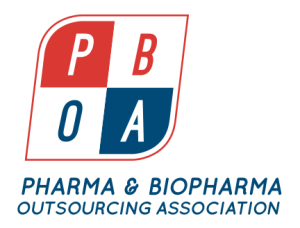On March 30, the Pharma & Biopharma Outsourcing Association (PBOA) held its first Regulatory/Legislative Workshop. The one-day event, held in the Washington, DC offices of Arnall Golden Gregory, was free for members of the PBOA, and featured speakers from FDA, PDA, PharmSource and TraceLink. Presentations included:
- GDUFA Overview • Keith Flanagan, Policy Director, Office of Generic Drugs/CDER/FDA
- Challenges and Expectations of Contract Manufacturing • Director, Manufacturing Quality Guidance and Policy Staff Office of Manufacturing Quality/Compliance/CDER/FDA
- FDA Metrics Program and Industry Response • Denyse Baker, Senior Advisor PDA Scientific and Regulatory Affairs, Parenteral Drug Association
- Preparing the CMO/CDMO Business for the Global Serialization Tsunami • Graham Clark, Global Head, CMO/CPO Partnerships, TraceLink
- Legislative Horizon • Alan K. Parver, Arnall Golden Gregory, LLP
- CMO Industry Update • Jim Miller, President, PharmSource and Chair, PBOA Advisory Committee
Each presentation included time for Q&A, and participants engaged in lively conversation with the speakers. PBOA President Gil Roth commented, “For the PBOA to develop and implement its agenda, its member companies need to interact with the groups that regulate them but also with one another. Events like this workshop enable both of those dialogues, and we’re looking forward to bringing our members together for more conversations like this one.”
The workshop began with Alan Parver’s analysis of the legislative landscape in 2015, and explored how initiatives like the House’s 21st Century CURES Act may impact the CMO/CDMO industry. He offered up an illustration of how difficult it’s been to get Congress to advance legislation, noting, “In the last Congress, 296 bills were passed. But the House of Representatives introduced 5,884 bills and Senate introduced 3,020 bills. And some of those 296 bills were to name buildings and roads. . . . It’s one thing to get a bill considered, but getting to the finish line is another issue.”
The next speaker was Keith Flanagan of FDA’s Office of Generic Drugs (OGD), who discussed the progress FDA has made in the first three years of GDUFA. He noted that GDUFA has faced a “perfect storm”, with its reorganization into a Super Office on par with the Office of New Drugs (OND), along with a move to White Oak, MD, implementation of new business processes across the agency, new staff and a new IT platform, twice the expected workload, and incoming ANDA submissions that have goal dates. He stressed the need for patience and noted that OGD has made significant strides in communicating with industry about GDUFA issues.
Recently, Mr. Flanagan added, the agency has begun assigning Target Action Dates (TADs) to all ANDA submissions that came in before year 3 of GDUFA. He addressed specific CDMO concerns, including the situation of CDMOs paying multiple years of Facility Fees with no insight as to when clients’ submissions may be acted on, and invited the PBOA and its members to participate in upcoming GDUFA public meetings.
Jim Miller of PharmSource offered up his patented industry overview, explaining how 45% of last year’s NDAs have had CMO/CDMO contributions, a nine-year record. He also noted the importance of small and mid-size pharma clients to the health the industry and discussed the dynamic of large CDMOs to smaller ones, in terms of involvement with NDAs. In the Q&A, the conversation involved ways for the PBOA to raise the profile of the CMO/CDMO industry, as well as other regulatory and legislative areas for the association to address, including requirements for high potency facilities and local content regulations in diverse markets.
After lunch, Paula Katz of FDA’s Office of Manufacturing Quality (OMQ) led a spirited discussion of FDA’s approach to CMOs. She began by noting that the Food and Drug Administration Safety and Innovation Act (FDASIA) doesn’t actually define contract manufacturing, but explained how numerous regulations relate to use of CMOs. She stressed that CMO/CDMOs need to work closely with both clients and regulatory bodies to develop better metrics, noting, “I’m fully cognizant that it’s a very complicated relationship,” and also talked about harmonization between CDER and the Office of Regulatory Affairs (ORA) to better convey the agency’s expectations at inspections. Ms. Katz also focused on the use of the Quality Agreement as a tool to comply with regs, and commented, “A Quality Agreement is something like a marriage contract and a prenuptial agreement; it should meet in the middle, not be dominated by one party.” She pointed out that the agreement should be led by the Quality/Manufacturing groups at each party, not by the Business Development or Legal functions.
Denyse Baker from the Parenteral Drug Association (PDA) provided a “where are we now?” take on the FDA’s Quality Metrics Program. She explored the history of the program, which originated out of the FDA’s drug shortage task force, and its goal of using metrics to develop a common language around objective measures of quality. Her presentation covered the various industry groups that gave input for the program — including PDA, BIO, PhRMA, GPhA, ISPE and CHPA — and the difficulties in reconciling their various approaches to metrics. In theory, she explained, if a drug manufacturing facility — either in-house or CDMO — failed to provide metrics to the program, it could result in a charge that the site’s products are “adulterated,” but she pointed out that the system can also potentially reward successful sites. She said, “One of the issues is how we do site-based metrics for CMOs, when a site is handling products from many different clients.” For CMOs, the program will have to resolve the issues relating to confidentiality of client product data; can a CMO share data with a client about systems related to other clients’ products?
Ms. Baker noted PDA’s recent Quality Metrics survey, which provided objective scoring of attributes in several areas and attempted to determine whether there’s a relationship between quality culture behavior and quality system maturity. Ms. Baker remarked, “FDA cares about quality products, sites and systems,” and noted that the PDA’s approach has “focused on maturity attributes and relationship to Quality Culture.” She hoped FDA will be careful in its final selection of metrics, keeping in mind the need for clear definitions and being aware of the cultural impact of identifying and collecting quality metrics.
Graham Clark of TraceLink closed out the workshop with a heavy-duty discussion of drug serialization. With U.S. (2017) and EU (2018) serialization requirements looming, more than 75% of the global market will have serialization regulations in place by the end of the decade, albeit with unharmonized specifications. He repeatedly pointed out the lack of communication from clients to their CMOs and contract packagers about this, bluntly saying, “No one wants to talk about the cost of setting up serialization.”
He implored the CMOs in attendance to talk to their clients about serialization plans, and also to talk internally about taking steps to build some portions of a serialization solution. “You need to get started by separating the big capital investments from other portions of the work,” he recommended. “A serialization setup can cost between $250,000 and $500,000 per packaging line, but what about other parts of the program?” He explained the opportunities that serialization presents for outsourcing providers, especially working with a cloud-based system for and implored them to get started with serialization before a wave of companies try to implement it at once.
The workshop ended after Mr. Clark’s presentation, but the attendees were already asking about the possibility of holding a followup later in 2015.
To learn more about the Pharma & Biopharma Outsourcing Association and its mission to advance the regulatory, legislative and general business interests of the CMO/CDMO industry, visit pharma-bio.org or contact gil.roth@pharma-bio.org.

